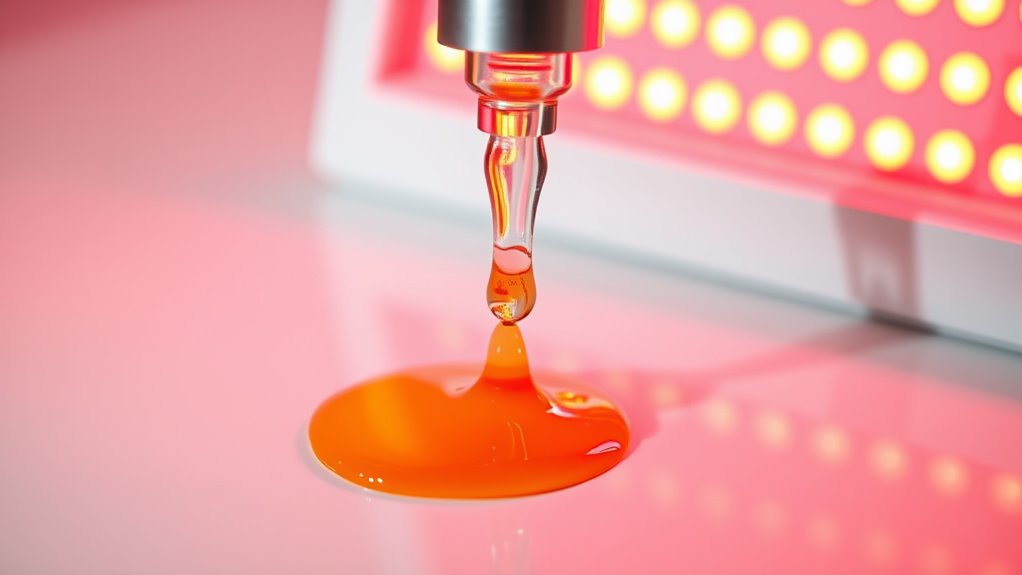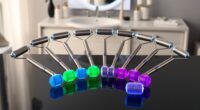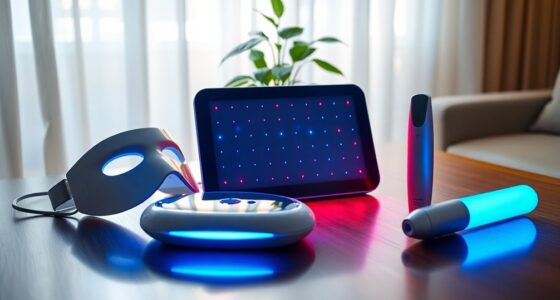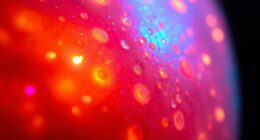Red light therapy plays a surprising role in boosting your skin’s ability to absorb topical vitamin C. It does this by increasing blood flow and temporarily making your skin more permeable, allowing nutrients to penetrate deeper. This enhanced absorption can lead to better skin brightness, elasticity, and overall health. If you want to discover how red light further amplifies skincare benefits, keep exploring this innovative approach to skin health.
Key Takeaways
- Red light therapy temporarily increases skin permeability, allowing deeper and more effective absorption of topical vitamin C.
- It stimulates skin cell activity and blood flow, enhancing nutrient delivery and overall skin health.
- Proper red light wavelengths prime the skin, boosting the efficiency of topical vitamin C absorption.
- Combining red light with vitamin C treatments results in improved skin brightness, elasticity, and rejuvenation.
- Ongoing research highlights red light therapy as a non-invasive method to optimize skincare outcomes through better nutrient uptake.
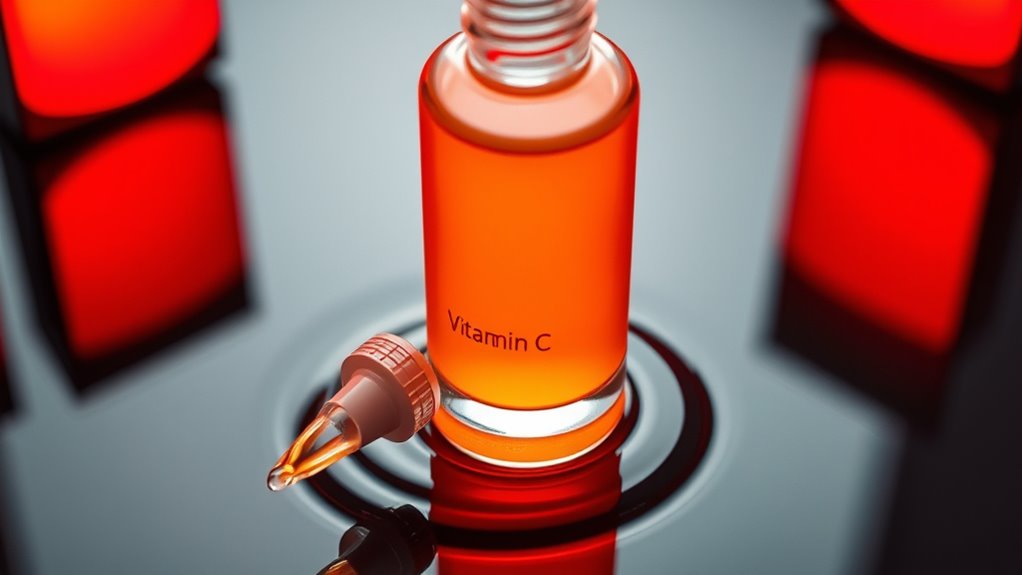
Red light therapy has gained popularity for its potential health benefits, but emerging research suggests it may also influence how your body absorbs essential nutrients like vitamin C. If you’re familiar with skincare routines or topical treatments, you might wonder how light exposure impacts nutrient absorption and skin health. Recent studies indicate that red light therapy can modify your skin’s permeability, making it more receptive to beneficial compounds like vitamin C. When you expose your skin to specific wavelengths of red light, it stimulates cellular activity and enhances blood flow, which can temporarily increase your skin’s permeability. This means that your skin becomes more receptive to topical applications, allowing nutrients to penetrate deeper and work more effectively.
The principle behind this involves red light’s ability to influence cellular processes that regulate skin barrier function. By stimulating the mitochondria within skin cells, red light therapy encourages increased energy production, which can help repair and maintain the integrity of your skin’s barrier. As your skin’s permeability improves, topical vitamin C—known for its antioxidant and collagen-boosting properties—can be absorbed more efficiently. This is particularly important because vitamin C, when absorbed effectively, can considerably enhance your skin’s brightness, elasticity, and overall health. Without sufficient absorption, even the most potent vitamin C serums won’t deliver their full benefits. Consequently, using red light therapy as a complementary treatment might optimize the effectiveness of your skincare products.
Additionally, red light therapy’s impact on skin permeability isn’t limited to just boosting absorption. It also promotes increased blood circulation in the treated area, bringing more nutrients and oxygen to your skin cells. This process can accelerate healing, reduce inflammation, and improve overall skin tone—all of which contribute to a healthier, more radiant complexion. When combined with topical vitamin C, the synergy between improved skin permeability and enhanced circulation can lead to more noticeable and longer-lasting results.
Furthermore, the use of specialized wavelengths in red light therapy has been shown to specifically target cellular processes that enhance skin receptivity, making it a promising adjunct in skincare routines. To get the most out of this approach, you might consider incorporating red light therapy sessions before applying your vitamin C serum. Doing so can prime your skin to absorb the nutrients more effectively. Just remember to follow proper protocols—such as the correct wavelength and session duration—to maximize the benefits. As research continues to evolve, it’s clear that red light therapy holds promise not just for skin rejuvenation but also for amplifying the power of topical nutrients like vitamin C, giving you a more efficient path to healthier, more radiant skin.
Frequently Asked Questions
Does Red Light Therapy Work for All Skin Types?
You might wonder if red light therapy works for all skin types. The good news is, it generally suits most skin tones and sensitivities because it’s gentle and non-invasive. However, if you have very sensitive skin or certain conditions, you should consult a dermatologist first. Red light therapy’s effectiveness isn’t limited by skin tone, making it accessible for many people looking to improve their skin health.
How Long Should Red Light Sessions Last for Optimal Absorption?
Think of your red light session as watering a delicate plant—too little, and it won’t thrive; too much, and it might drown. For ideal absorption, aim for a session duration of about 10 to 20 minutes, which allows your skin to soak up the benefits without overdoing it. The key is consistent, well-timed sessions that match your skin’s needs, ensuring you get the radiant glow you’re after.
Are There Any Side Effects From Combining Red Light With Vitamin C?
You might wonder if combining red light with vitamin C causes side effects. Generally, it’s safe, but some people could experience phototoxic reactions or skin irritation, especially if they have sensitive skin or are prone to allergies. To minimize risks, start with shorter sessions and monitor your skin’s response. If you notice redness, discomfort, or other reactions, stop treatment and consult a dermatologist to guarantee safe use.
Can Red Light Improve Absorption of Other Skincare Ingredients?
Red light therapy can enhance ingredient penetration in your skincare routine. When you use light therapy, it stimulates your skin cells, making them more receptive to active ingredients. This process can improve absorption of various skincare ingredients, not just vitamin C. So, if you’re aiming for better results, incorporating red light may boost how effectively your products penetrate your skin, leading to healthier, more radiant skin over time.
Is Red Light Therapy Suitable for Sensitive or Reactive Skin?
Did you know over 15% of people report skin sensitivity issues? When considering red light therapy, you should be cautious if your skin is sensitive or reactive, as red light caution applies. While many find it gentle, some may experience irritation. Always start with a patch test, and consult a dermatologist to make sure red light therapy is appropriate for your skin type, preventing potential flare-ups.
Conclusion
As you explore this innovative approach, you’ll find that integrating red light therapy subtly enhances your skin’s receptivity to vitamin C. This delicate synergy may quietly elevate your skincare routine, offering a gentle yet profound boost. Embracing these gentle advancements allows you to enjoy healthier, more radiant skin without upheaval. Ultimately, it’s about nurturing your natural beauty with subtle, sophisticated techniques that work in harmony, revealing your skin’s true potential in the most refined way.
